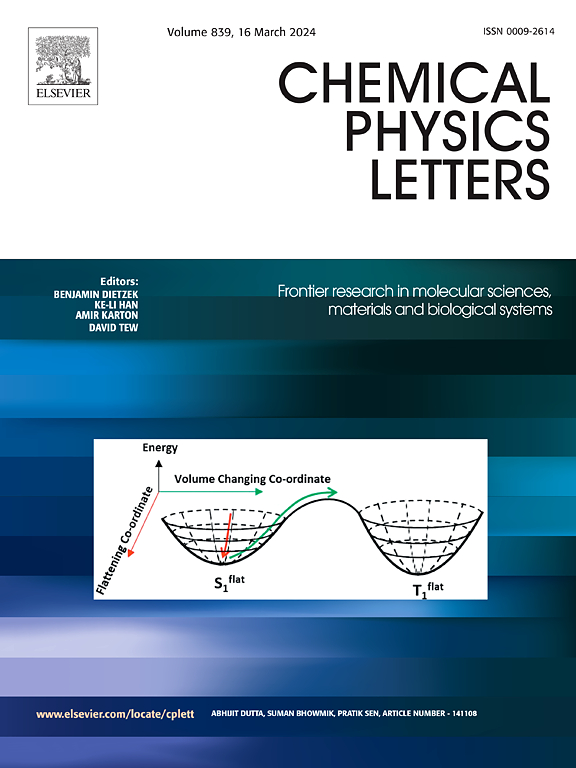Si52、C52、Al26P26纳米笼及其卤素掺杂衍生物作为金属离子电池阳极的电势研究
IF 2.8
3区 化学
Q3 CHEMISTRY, PHYSICAL
引用次数: 0
摘要
测试了Si52、C52和Al26P26在电池中的容量。计算了FSi52、BrSi52、FC52、BrC52、F-Al26P26和Br-Al26P26在电池中的内聚能、电压和理论容量。Mg+2离子与纳米结构的相互作用能明显小于Na+离子。纳米笼对卤素的吸附可以提高其在电池中的Vcell和Ctheory。Si52、FSi52、BrSi52、C52、FC52、BrC52、Al26P26、F-Al26P26、Br-Al26P26的Vcell从2.21 V变化到3.99 V, Ctheory值从553变化到999 mAhg−1。镁离子电池中F-Al26P26和Br-Al26P26的理论容量高于电池中的纳米管和纳米笼。F-Al26P26和Br-Al26P26纳米笼与Na+和Mg+2离子的相互作用最强,具有最低的Vcell值和最高的c理论值,是金属离子电池的有效负极材料。本文章由计算机程序翻译,如有差异,请以英文原文为准。

Examination of potential of Si52, C52, Al26P26 nanocages and their halogen doped derivatives as anodes in metal-ion battery
The capacities of the Si52, C52 and Al26P26 in batteries are examined. The cohesive energies, voltage cell and theoretical capacity of the F![]() Si52, Br
Si52, Br![]() Si52, F
Si52, F![]() C52, Br
C52, Br![]() C52, F-Al26P26 and Br-Al26P26 in batteries are calculated. The interaction energy of Mg+2 ion with nanostructures are more negative than Na+ ion, significantly. The adsorption of halogen on nanocages can be increased their Vcell and Ctheory in batteries. The Vcell of Si52, F
C52, F-Al26P26 and Br-Al26P26 in batteries are calculated. The interaction energy of Mg+2 ion with nanostructures are more negative than Na+ ion, significantly. The adsorption of halogen on nanocages can be increased their Vcell and Ctheory in batteries. The Vcell of Si52, F![]() Si52, Br
Si52, Br![]() Si52, C52, F
Si52, C52, F![]() C52, Br
C52, Br![]() C52, Al26P26, F-Al26P26, Br-Al26P26 are changed from 2.21 to 3.99 V and their Ctheory values are changed from 553 to 999 mAhg−1. The theoretical capacity of F-Al26P26 and Br-Al26P26 in Mg-ion batteries are higher than nanotubes and nanocages in batteries. The F-Al26P26 and Br-Al26P26 nanocages are proposed as effective anode materials in metal-ion batteries with high performance due to strongest Einteraction with Na+ and Mg+2 ions, the lowest Vcell values and the highest Ctheory values.
C52, Al26P26, F-Al26P26, Br-Al26P26 are changed from 2.21 to 3.99 V and their Ctheory values are changed from 553 to 999 mAhg−1. The theoretical capacity of F-Al26P26 and Br-Al26P26 in Mg-ion batteries are higher than nanotubes and nanocages in batteries. The F-Al26P26 and Br-Al26P26 nanocages are proposed as effective anode materials in metal-ion batteries with high performance due to strongest Einteraction with Na+ and Mg+2 ions, the lowest Vcell values and the highest Ctheory values.
求助全文
通过发布文献求助,成功后即可免费获取论文全文。
去求助
来源期刊

Chemical Physics Letters
化学-物理:原子、分子和化学物理
CiteScore
5.70
自引率
3.60%
发文量
798
审稿时长
33 days
期刊介绍:
Chemical Physics Letters has an open access mirror journal, Chemical Physics Letters: X, sharing the same aims and scope, editorial team, submission system and rigorous peer review.
Chemical Physics Letters publishes brief reports on molecules, interfaces, condensed phases, nanomaterials and nanostructures, polymers, biomolecular systems, and energy conversion and storage.
Criteria for publication are quality, urgency and impact. Further, experimental results reported in the journal have direct relevance for theory, and theoretical developments or non-routine computations relate directly to experiment. Manuscripts must satisfy these criteria and should not be minor extensions of previous work.
 求助内容:
求助内容: 应助结果提醒方式:
应助结果提醒方式:


